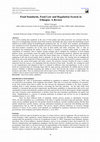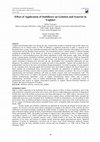Papers by Melese Temesgen

Journal of Thrombosis and Thrombolysis, 2020
Few data are available regarding epidemiology and outcomes of Philadelphia-negative chronic myelo... more Few data are available regarding epidemiology and outcomes of Philadelphia-negative chronic myeloproliferative neoplasms (MPN) in Latin America. Therefore, current models for MPN treatment are based in large cohorts of patients from Europe and North America. In this paper, we conducted a retrospective study to evaluate thrombotic and bleeding events in a cohort of patients with MPN from a reference center in Brazil. A total of 334 patients were included, being essential thrombocythemia the most common diagnosis. Here, we found that 41% of the MPN patients had a thrombotic event prior to the diagnosis. Thrombosis was more frequent in patients under 60 years-old. In a multivariable model, only JAK2 V617F mutation (OR 2.57 95% CI 1.58–4.18, p < 0.001) and presence of two cardiovascular risk factors (OR 1.90 95% CI 1.21–2.98, p < 0.005) were significant for thrombosis. The risk of thrombosis was similar among all subtypes of MPN. Cumulative incidence of thromboembolic event at 5 years from diagnosis was 5.8% (95% CI 3.5–8.9), which is similar to previous studies. The high incidence of thromboembolic events in younger patients suggests that socioeconomic disparities might have a role in the outcomes of MPN
International Journal of Food Properties, 2022
L'oeuvre scientifique, sociologique, épistémologique et philosophique d'Edgar Morin est immense e... more L'oeuvre scientifique, sociologique, épistémologique et philosophique d'Edgar Morin est immense et il n'est pas question ici de la synthétiser. Cette année, plusieurs colloques de par le monde ont lieu en l'honneur de son centième anniversaire. L'objectif de ce Hommage à Edgar Morin : L'épistémologie écosystémique de la complexité vers u...

The study was conducted to evaluate the pretreatment effects of ascorbate and osmotic solution on... more The study was conducted to evaluate the pretreatment effects of ascorbate and osmotic solution on oven dried and pickled mushrooms. Significant differences in nutritional composition and sensory quality were observed between the pickled and dried samples of mushrooms. Pickling obtained in high moisture content, crude fibre, crude fat, crude protein, soluble solid and ash content, however, the content of carbohydrates and dry matter were lower than oven drying. Both osmotic and ascorbate pretreatments significantly affected the composition. As result, ascorbate concentration increased the protein, ash and fat contents of mushroom samples. In contrary to ascorbate pretreatment, osmotic solution pretreated mushrooms resulted in highest rehydration capacity. The sensory evaluation results of the pickled mushrooms products had more acceptances and acquired good colour, flavour and overall acceptability than that of oven dried products. Ascorbate treatments combined with pickling are adva...
Cogent food & agriculture, 2021
There is currently an emerging problem of protein malnutrition in Ethiopia. This food formulation... more There is currently an emerging problem of protein malnutrition in Ethiopia. This food formulation was done to increase the accessibility of nutrient-rich food products for the consumers. Lupine is ...
A Dissertation Submitted to the Department of Plant Biology and Biodiversity Management Presented... more A Dissertation Submitted to the Department of Plant Biology and Biodiversity Management Presented in Fulfillment of the Requirements for the Degree of Doctor of Philosophy Food Science and Nutrition.

Food Science and Quality Management, 2015
The study was conducted to evaluate the pretreatment effects of ascorbate and osmotic solution on... more The study was conducted to evaluate the pretreatment effects of ascorbate and osmotic solution on oven dried and pickled mushrooms. Significant differences in nutritional composition and sensory quality were observed between the pickled and dried samples of mushrooms. Pickling obtained in high moisture content, crude fibre, crude fat, crude protein, soluble solid and ash content, however, the content of carbohydrates and dry matter were lower than oven drying. Both osmotic and ascorbate pretreatments significantly affected the composition. As result, ascorbate concentration increased the protein, ash and fat contents of mushroom samples. In contrary to ascorbate pretreatment, osmotic solution pretreated mushrooms resulted in highest rehydration capacity. The sensory evaluation results of the pickled mushrooms products had more acceptances and acquired good colour, flavour and overall acceptability than that of oven dried products. Ascorbate treatments combined with pickling are adva...

This study was conducted to investigate the effect of lupine flour on functional properties and s... more This study was conducted to investigate the effect of lupine flour on functional properties and sensory acceptability of tef-lupine blended injera. Injera is a staple food for Ethiopian and it is fermented, sour leavened pancake-like bread made from blending of different cereals like tef, barley, sorghum, maize and wheat. Besides, there are limited studies on formulating of injera from composite flour with legumes (lupine). The effect of two factors two lupine varieties (Australian sweet lupine and Dibettered lupine seed) and blending ratios. Maximum and minimum levels of independent variables were first investigated by doing a preliminary analysis and funded that tef from up to10080% and lupines from up to 0-20%. Response surface methodology was applied to find the formulations and predictive model. Sensory acceptance of tef-lupine injera was affected by interaction of varieties and blending ratios. Oil absorption capacity and swelling power properties of composite flour decrease a...

Public Policy and Administration Research, 2015
It is worth recalling that regulation in the area of food quality and safety protection was emerg... more It is worth recalling that regulation in the area of food quality and safety protection was emerged with the objectives of safeguarding consumers from both economic and health risks and to ensure the functioning of food markets in an orderly manner by prohibiting the production and sale of unsafe food products and fraudulent acts committed on foods. Ensuring the quality and safety of domestically produced, exported and imported food and food products constitutes one of the areas of food quality and safety protection. This is with an assumption that maintaining the quality of these foods is essential to protect public health, to satisfy the expectation of consumers, and to enhance foreign earnings and to maintain the confidence of food trading partners. Hence, governments assure the quality and safety of domestically produced, imported and exported food and food products. It has been noted that foods related laws in Ethiopia also do not meet what the supplying of safe and of go...

Journal of environment and earth science, 2015
Food security and environmental issues are growing, bringing about the need for more sophisticate... more Food security and environmental issues are growing, bringing about the need for more sophisticated control of industrial emissions and waste. Emissions and waste from food processing industries are one of the potential sources of climate change and food insecurity that have remarkable effects on environment interlinked with food productivity and nutritional status. It is also reducing fertility of land, degradation of natural ecosystem and purity of water, productivity of seeds, efficiency of pesticides and endurance of agrobiodiversity used for food production. Chemical residues and food containments in the form of wastes emitted from dairy, brewery, winery, beverage, fruits and vegetable, meat and poultry processing industries have been reconsidered as the cause for climate change. Therefore, there must be strategies to alleviate climate change due to food industry residues, chemicals and wastes. This could be achieved by reducing loss and waste in the food system, recycling and...

Food Science and Quality Management, 2015
The objective of this review was to present the nutritional values and other health and food secu... more The objective of this review was to present the nutritional values and other health and food security importance of taro as alternative food for developing countries. The term taro is used to refer to Colocasia esculenta (L.). It is a family of Aracea cultivated for its edible corms. Taro is used as a staple food or subsistence food by millions of people in the developing countries in Asia, Africa and Central America. Taro has much importance in ensuring food security, in earning foreign currency as being a cash crop and also as a means for rural development. Nutritionally, Taro contains more than twice the carbohydrate content of potatoes and yield 135 kcals per 100 g. Taro contains about 11% protein on a dry weight basis. This is more than yam, cassava or sweet potato. Many authors also stated that the protein content of taro is higher than the other root crops in leaves and tuber respectively. It contains 85-87% starch on dry matter basis with small granules size of 3-18 µm and ...

In Ethiopia, in highly populated areas where it may be complex to continue agronomic activities, ... more In Ethiopia, in highly populated areas where it may be complex to continue agronomic activities, subsistence poultry can be the best alternative form of income resources, plays a significant role in family nutrition and above all, smallholder poultry provide a good opportunity to address poverty alleviation.1 However, scarcity of conventional feedstuffs and food insecurity problems by rapidly increasing population growth are the most aggravating factors at present (FAO, 2014). Most of the population in Ethiopia depends on cereals as stable foods which are also required for poultry feeding.2 This means, it is difficult to use cereals for poultry with having human food insecurity burden and replacing expensive cereals and less available agro-industrial by-products by unconventional source of raw materials, which are less exploited by man, is one of the solutions to reduce cost of production and contribute to increased supply of animal protein to rich of poor people’s.3,4 Diets formula...

Yoghurt and fermented milks were among the most common dairy products consumed in the world, whic... more Yoghurt and fermented milks were among the most common dairy products consumed in the world, which were estimated to be 8.3 million tonnes in 1999. In Ethiopia, a significant proportion of milk is consumed in its fermented form as Ergo. Ergo (naturally fermented sour milk) has similar properties with yoghurt; it is a semi-solid product and has pleasant aroma and taste. The fermentation process, usually natural, is affected through spontaneous proliferation of the initial raw milk flora at ambient temperature. However, modern yoghurt production is a well-controlled process that utilizes ingredients of milk, milk powder, sugar, fruits, flavoring agents, coloring agents, emulsifiers, stabilizers, and pure cultures of lactic acid bacteria, which are responsible for the fermentation process. Yoghurt is a product of lactic acid fermentation of milk by addition of a starter culture consisting of Streptococcus salivarius sub spp. thermophilus and Lactobacillus delbrueckii sub spp. Bulgaricu...

A study was conducted to evaluate the effect of age and breeds (Arsi, Borana, HF-Cross and Harar)... more A study was conducted to evaluate the effect of age and breeds (Arsi, Borana, HF-Cross and Harar) on carcass and meat characteristics of bulls finished under similar feeding conditions. The feeding experiment was conducted for 90 days at Beef farm of Haramaya University. In this experiment, 24 bulls were fed with roughage (60%) which contained grass hay and wheat straw and concentrate (40%) which contained wheat bran, noug (gucia abysica) cake, maize grain, limestone, salt and ruminant premix. The bulls were transported to Bishoftu ELFORA export abattoir for slaughter following the procedure of the abattoir. The result of the study revealed that the average slaughter weight, hot carcass weight, cold carcass weight, shrink loss, commercial dressing and true dressing percentage were 179.1 kg, 86.8 kg, 82.7 kg 4.7%, 48.8% and 78.3%, respectively. Total edible and nonedible offal were significantly (P significantly (P Boran, Harar, and HF-crossbred were 78.1%, 77%, 72.8% and 77.2% respe...

The study was conducted to evaluate the fattening performance of Arsi, Borana, Harar and HF-Cross... more The study was conducted to evaluate the fattening performance of Arsi, Borana, Harar and HF-Crossbred bulls finished under similar feeding condition at the beef farm in Haramaya University. A total of 24 bulls with age categories of 2-3 and 4-5 years were used in the complete block design for the experiment. Total mixed ration was provided at 3% of their BW during experimental periods. The average daily weight gain of the four breeds range from 0.49 to 0.71 kg. Feed conversion efficiency also ranges from 0.11 – 0.15. Simple linear regression models were used to explore the relationship between live body weight change and change in BCS as well as seven linear body measurements for all age groups. An average change for a unite of body condition score was equivalent to 20.3, 20.61, 22.42 and 27.78kg for Borana, Arsi, Harar and HF-crossbred bulls respectively. BCS was significantly (P<0.01) influenced by breeds. There was a significant (P<0.05) breed by age interaction effect on t...

Food Science and Quality Management, 2015
Consumption of cow's milk and milk products is associated with overall diet quality and adequacy ... more Consumption of cow's milk and milk products is associated with overall diet quality and adequacy of intake of many essential nutrients including calcium, potassium, phosphorus, protein, vitamins A, D (if fortified), and B12, riboflavin, and niacin. Unfortunately, some individuals may avoid milk and milk products unnecessarily because of adverse reactions to these foods. Because of its nutrient-rich package, consumption of dairy foods can play a unique role in helping to promote health. People who avoid milk and milk products due to lactose intolerance miss many benefits, as dairy and its nutrients are associated with: Improved nutrient intake and diet quality. Cow's milk allergy is an immunologically mediated response to one or more of cow's milk proteins. Lactose intolerance, a no immunological reaction, is the occurrence of symptoms after persons with low levels of the enzyme lactase (lactose maldigesters) consume lactose (milk sugar) in amounts exceeding lactase's ability to digest it. Cow's milk protein allergy occurs primarily in infancy and early childhood. Moreover, the condition tends to be outgrown by 5 years of age. In contrast to cow's milk allergy, which occurs primarily in infancy and young childhood, lactose intolerance (symptoms) seldom occurs prior to preadolescence.

Advances in Life Science and Technology, 2015
The objective of this review was to address long term intake of dietary fat result fat induced In... more The objective of this review was to address long term intake of dietary fat result fat induced Insulin resistance and other non communicable diseases with reference to hypertension, diabetes, obesity, cancer, cholesterol and cardio vascular diseases. Dietary fats, or lipids, are a macronutrient class that includes fatty acids, triglycerides, and cholesterol. Fatty acid quantity and quality also vary by their source, with important differences between meat, fish, and plant sources, as well as natural versus synthetic sources. This heterogeneity allows for food consumption choices to modulate the quantity and quality of fats that, in turn, influence metabolic and health outcomes. The dietary intake of fat has received considerable attention in the past few decades because of its link with an increased risk of coronary heart disease (for high intakes of saturated fatty acids and cholesterol) and obesity (for a high intake of total fat). Currently, several lines of evidence indicate that the type of fat is more important in decreasing metabolic and CVD risk than the total amount of fat in the diet. The scientific evidence is clear that a high-fat diet relates to chronic health problems such as heart disease, cancer, diabetes, and obesity. Therefore that, books, cookbooks, and magazine articles tout low-fat messages. Saturated fat or the bad fats are a significant risk factor for cardiovascular diseases (CVD) including heart disease and stroke through raising blood total cholesterol and LDL cholesterol levels. On the other hand, the good fats or the unsaturated fats – monounsaturated fats, omega 3 polyunsaturated fats (PUFA) and omega 6 polyunsaturated fats primarily protect against CVD through their effects on cholesterol i.e. lowering harmful LDL cholesterol and raising protective HDL cholesterol. Concerning Insulin sensitivity and resistance, it is important to understand TFA consumed during long periods could promote insulin resistance and have clinically relevant effects on diabetes risk. The reviews showed that Insulin resistance is associated with type 2 diabetes mellitus (T2DM), cardiovascular diseases (CVD) and thus, Insulin resistance (IR) is considered the key mechanism unifying obesity, diabetes and heart disease. Globalization and Immigration also have contribution to increased consumption of high-fat, energy-dense diets, particularly rich in saturated fatty acids (SFAs). All age groups and all regions are affected by NCDs. Children, adults and the elderly are all vulnerable to the risk factors that contribute to noncommunicable diseases, whether from unhealthy diets, physical inactivity, exposure to tobacco smoke or the effects of the harmful use of alcohol. The situation is double burden for low-income and middle-income countries and is the most remaining public problem. This clearly shows that there must be global action for the prevention and control of noncommunicable diseases focussing on healthy diet and physical activity as a public health priority. Keywords: dietary fat, Insulin resistance, NCD and globalization

Food Science and Quality Management, 2015
The objective of this review was to present the nutritional values and other health and food secu... more The objective of this review was to present the nutritional values and other health and food security importance of taro as alternative food for developing countries. The term taro is used to refer to Colocasia esculenta (L.). It is a family of Aracea cultivated for its edible corms. Taro is used as a staple food or subsistence food by millions of people in the developing countries in Asia, Africa and Central America. Taro has much importance in ensuring food security, in earning foreign currency as being a cash crop and also as a means for rural development. Nutritionally, Taro contains more than twice the carbohydrate content of potatoes and yield 135 kcals per 100 g. Taro contains about 11% protein on a dry weight basis. This is more than yam, cassava or sweet potato. Many authors also stated that the protein content of taro is higher than the other root crops in leaves and tuber respectively. It contains 85-87% starch on dry matter basis with small granules size of 3-18 µm and other nutrients such as minerals, Vitamin C, thiamin, riboflavin and niacin better than other cereals. Taro leaves, like higher plants, is rich in protein. The high protein content of the leaves favourably complements the high carbohydrate content of the tubers. In other parts of the world, the leaves of Colocasia esculenta have been reported to be rich in nutrients, including minerals such as calcium, phosphorus, iron, and vitamins like vitamin C, thiamine, riboflavin and niacin. High levels of dietary fibre in taro are also advantageous for their active role in the regulation of intestinal transit, increasing dietary bulk and faeces consistency due to their ability to absorb water. Most rural peoples suffer from malnutrition not because of the economic status but because of inability to utilize the available nutritious raw materials to meet their daily requirements. Now a day, zinc deficiency is widespread and affects the health and well-being of populations worldwide and since taro is one of the few nonanimal sources of zinc, its utilization should therefore be pursued to help in the alleviation of zinc deficiency which is associated to stunting.

Food Science and Quality Management, 2015
Yoghurt and fermented milks were among the most common dairy products consumed in the world, whic... more Yoghurt and fermented milks were among the most common dairy products consumed in the world, which were estimated to be 8.3 million tonnes in 1999. In Ethiopia, a significant proportion of milk is consumed in its fermented form as Ergo. Ergo (naturally fermented sour milk) has similar properties with yoghurt; it is a semisolid product and has pleasant aroma and taste. The fermentation process, usually natural, is affected through spontaneous proliferation of the initial raw milk flora at ambient temperature. However, modern yoghurt production is a well-controlled process that utilizes ingredients of milk, milk powder, sugar, fruits, flavoring agents, coloring agents, emulsifiers, stabilizers, and pure cultures of lactic acid bacteria, which are responsible for the fermentation process. Yoghurt is a product of lactic acid fermentation of milk by addition of a starter culture consisting of Streptococcus salivarius sub spp. thermophilus and Lactobacillus delbrueckii sub spp. Bulgaricus. The addition of sweeteners in yoghurt has made it more palatable. Yoghurt with no added flavor is predominantly sour due to the lactic acid produced during fermentation. For better acceptance of such yoghurts by the consumer, fruits, flavoring agents and sweeteners have been added to improve the flavor balance or to mask partially the acetaldehyde flavor characteristics. Therefore the application of stabilizers in yoghurt manufacturing will bring a positive effect on product stability and consumer acceptance. The review of yoghurt manufacturing and associated stabilizers will help for further research study and development work. The objectives of this review is to address The objective of the paper Yoghurt manufacturing, Common principles in yoghurt manufacturing, Ingredients used in yoghurt manufacturing, Starter culture used in yoghurt manufacturing, Sweeteners used in yoghurt manufacturing, stabilizers used in yoghurt,the science of gelatinization and synersis in yoghurt, nutraceutical properties of yoghurt, Physico-Chemical Properties of Yoghurt and Sensory Properties of Yoghurt.

International Journal of Scientific Reports
Irrational use of medicines causes numerous harmful consequences including reduction in quality o... more Irrational use of medicines causes numerous harmful consequences including reduction in quality of ABSTRACT Background: Inappropriate use of medicines becomes a common global problem. The aim of this study was to assess the drug prescription patterns at Bole health center, using some of the World Health Organization (WHO) core drug use indicators. Methods: A cross-sectional study was conducted to determine the current prescribing practices at the health center. A sample of 720 prescriptions was selected by using stratified random sampling method from 11,040 prescriptions written for the 5 month period from August 1-December 30, 2016. Data were collected from prescription papers filed in the pharmacy. Results: The average number of drugs prescribed per encounter was 2.03. The percentage of encounters in which antibiotics prescribed was 67.36%. The proportion of drugs prescribed by generic name and from an essential drug list was 98.14% and 99.25%, respectively. Conclusions: The prescribing practice for antibiotic and average number of medicines per prescription shows deviation from the standard recommended by WHO. Great emphasis should be given to restrict inappropriate use of antibiotics.











Uploads
Papers by Melese Temesgen